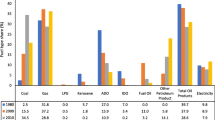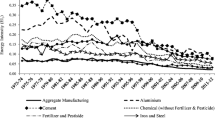Abstract
Decomposition analysis is a proven approach to highlight the trends in energy economics and to clarify the changing factors in energy consumption. In Turkey, industrial sector is one of the major drivers of economy, which accounts for 32% of the final energy consumption. This paper uses the logarithmic mean Divisia index (LMDI) to divide the total energy consumption growth of ten Turkish manufacturing industries into activity effect, structure effect, and intensity effect in the period from 2005 to 2014. Manufacturing subsectors consist of (a) food products, beverages, and tobacco, (b) textile and textile products, (c) wood and wood products, (d) pulp, paper, and paper products; publishing and printing, (e) chemicals, chemical products, and man-made fibers, (f) rubber and plastic products, (g) non-metallic mineral products, (h) primary metals, (i) equipment goods, and (j) other manufacturing. Energy consumption of total manufacturing industry rose from 25,013 ktoe to 27,590 ktoe within the period. The subsector (a), (b), (c), (d), (e), (f), and (i) analyses results reveal that the activity effect has significant contribution to energy consumption, while structure and intensity effects are negligible. On the other hand, for the energy-intensive industries, influence of structure and intensity effects has observed simultaneously. The results also show that intensity and activity effects follow similar trends. Energy intensity of manufacturing industry has followed a slightly decreasing route (0.288 ktoe/$2005 in 2005 and 0.219 ktoe/$2005 in 2014) in the period, which is an indicative of contribution of activity changes, energy efficient technologies, and other energy efficiency efforts.





Similar content being viewed by others
References
Akbostancı, E., Tunç, I. G., & Türüt-Aşık, S. (2011). CO2 emissions of Turkish manufacturing industry: a decomposition analysis. Applied Energy, 88, 2273–2278.
Akyurek, Z. (2019). Sustainable valorization of animal manure and recycled polyester: co-pyrolysis synergy. Sustainability, 11(8), 2280.
Ang, B. W. (2004). Decomposition analysis for policymaking in energy: which is the preferred method? Energy Policy, 32, 1131–1139.
Ang, B. W. (2005). The LMDI approach to decomposition analysis: a practical guide. Energy Policy, 33, 767–773.
Ang, B. W. (2015). LMDI decomposition approach: a guide for implementation. Energy Policy, 86, 233–238.
Ang, B. W., & Choi, K. H. (1997). Decomposition of aggregate energy and gas emission intensities for industry: a refined Divisia index method. The Energy Journal, 18, 59–73.
Ang, B. W., & Liu, F. L. (2001). A new energy decomposition method: perfect in decomposition and consistent in aggregation. Energy, 26, 537–548.
Ang, B. W., & Xu, X. Y. (2013). Tracking industrial energy efficiency trends using index decomposition analysis. Energy Economics, 40, 1014–1021.
Ang, B. W., & Zhang, F. Q. (2000). A survey of index decomposition analyses in energy and environmental studies. Energy, 25, 1149–1176.
Ang, B. W., Zhang, F. Q., & Choi, K. H. (1998). Factorizing changes in energy and environmental indicators through decomposition. Energy, 23, 489–495.
Baksi, S., & Green, C. (2007). Calculating economy-wide energy intensity decline rate: the role of sectoral output and energy shares. Energy Policy, 35, 6457–6466.
Blok, K. (2007). Introduction to energy analysis (1st ed.). Amsterdam: Techne Press (ISBN: 90-8594-016-8).
Cahill, C., Gallachoir, B. O., (2009). Comparing the use of ODEX indicators with divisia decomposition analysis to measure true energy efficiency achievements: case Irish industry. ECEE 2009 Summer Study. 1147-54.
Choi, K. H., & Oh, W. (2014). Extended divisia index decomposition of changes in energy intensity: a case of Korean manufacturing industry. Energy Policy, 65, 275–283.
Chontanawat, J., Wiboonchutikula, P., & Buddhivanich, A. (2014). Decomposition analysis of the change of energy intensity of manufacturing industries in Thailand. Energy, 77, 171–182.
Cornillie, J., & Fankhauser, S. (2004). The energy intensity of transition countries. Energy Economics, 26, 283–295.
Cui, Y., Geng, Z., Zhu, Q., & Hana, Y. (2017). Review: multi-objective optimization methods and application in energy saving. Energy, 125, 681–704.
Duran, E., Aravena, C., & Aguilar, R. (2015). Analysis and decomposition of energy consumption in the Chilean industry. Energy Policy, 86, 552–561.
Ediger, V. Ş., & Huvaz, O. (2006). Examining the sectoral energy use in Turkish economy (1980-2000) with the help of decomposition analysis. Energy Conversion and Management, 47, 732–745.
Energy Balance Sheets of Turkey, 2005–2014. Turkish Republic Ministry of Energy and Natural Resources. (2015). http://www.eigm.gov.tr/en-US/Balance-Sheet. Accessed 20 December 2019.
Energy efficiency indicators: essentials for policymaking International Energy Agency (2014). http://www.iea.org/publications/freepublications/publication/IEA_EnergyEfficiencyIndicators_EssentialsforPolicyMaking.pdf. .
Energy Efficiency Policy Recommendations. International Energy Agency (IEA). (2011) https://webstore.iea.org/25-energy-efficiency-policy-recommendations-2011. Accessed 7 February 2020.
Energy Efficiency Strategy Paper 2012-2023. Turkish Republic Ministry of Energy and Natural Resources http://www.eie.gov.tr/verimlilik/document/Energy_Efficiency_Strategy_Paper.pdf/. Accessed 20 December 2019.
Energy Intensity, Indicator assessment report 2016, EEA https://www.eea.europa.eu/data-and-maps/indicators/total-primary-energy-intensity-3/assessment. Accessed 20 December 2019.
Energy intensity of the economy, Eurostat, (1995-2014). http://ec.europa.eu/eurostat/tgm/table.do?tab=table&init=1&plugin=1&language=en&pcode=tsdec360. Accessed 20 December 2019.
Energy Intensity Statistics Report, General directorate of renewable energy (2015). http://www.eie.gov.tr/document/WEB_enerjiyogunlugu_28122015.doc. Accessed 20 December 2019.
Energy Policies for IEA Countries: Turkey (2016). https://euagenda.eu/upload/publications/untitled-53148-ea.pdf. Accessed 7 February 2020.
European Comission Directorate General for the Energy and Transport (2008). https://www.energy.eu/publications/KOAC07001ENC_002.pdf. Accessed 7 January 2020.
European Commission (2013) https://doi.org/10.2833/17897. http://ec.europa.eu/transport/sites/transport/files/media/publications/doc/trends-to-2050-update-2013.pdf. Accessed 7 February 2020.
Final energy consumption, EU-28 (% of total, based on tonnes of oil equivalent), Eurostat (2014). http://ec.europa.eu/eurostat/statistics-explained/index.php/File:Final_energy_consumption,_EU-28,_2014_(%25_of_total,_based_on_tonnes_of_oil_equivalent)_YB16.png. Accessed 20 December 2019.
Geng, Z., Gao, H., Wang, Y., Han, Y., & Zhu, Q. (2017a). Energy saving analysis and management modeling based on index decomposition analysis integrated energy saving potential method: application to complex chemical processes. Energy Conversion and Management, 145, 41–52.
Geng, Z., Yang, X., Han, Y., & Zhu, Q. (2017b). Energy optimization and analysis modeling based on extreme learning machine integrated index decomposition analysis: application to complex chemical processes. Energy, 120, 67–78.
Geng, Z., Dong, J., Han, Y., & Zhu, Q. (2017c). Energy and environment efficiency analysis based on an improved environment DEA cross-model: case study of complex chemical processes. Applied Energy, 205, 465–476.
Geng, Z., Quin, L., Han, Y. M., & Zhu, Q. X. (2017d). Energy saving and prediction modeling of petrochemical industries: a novel ELM based on FAHP. Energy, 122, 350–362.
Hammond, G. P., & Norman, J. B. (2012). Decomposition analysis of energy-related carbon emissions from UK manufacturing. Energy, 41, 220–227.
Han, Y., Geng, Z., Zhu, Q., & Qu, Y. (2015). Energy efficiency analysis method based on fuzzy DEA cross-model for ethylene production systems in chemical industry. Energy, 83, 685–695.
Han, Y., Zeng, H., Geng, Z., & Zhu, Q. (2018). Energy management and optimization modeling based on a novel fuzzy extreme learning machine: case study of complex petrochemical industries. Energy Conversion and Management, 165, 163–171.
Hasanbeigi, A., Price, L., Fino-Chen, C., Lu, H., & Ke, J. (2013). Retrospective and prospective decomposition analysis of Chinese manufacturing energy use and policy implications. Energy Policy, 63, 562–574.
International Energy Outlook 2017 Report, International Energy Agency (2017) https://www.eia.gov/outlooks/ieo/pdf/0484(2017).pdf. Accessed 20 December 2019.
Jia, J., Jian, H., Xie, D., Gu, Z., & Chen, C. (2019). Multi-scale decomposition of energy-related industrial carbon emission by an extended logarithmic mean Divisia index: a case study of Jiangxi, China. Energy Efficiency, 12, 2161–2186.
Kumbaroğlu, G. (2011). A sectoral decomposition analysis of Turkish CO2 emissions over 1990-2007. Energy, 36, 2419–2433.
Lin, B., & Du, K. (2014). Decomposing energy intensity change: a combination of index decomposition analysis and production-theoretical decomposition analysis. Applied Energy, 129, 158–165.
Lise, W. (2006). Decomposition of CO2 emissions over 1980-2003 in Turkey. Energy Policy, 34, 1841–1852.
Manufacturing sector in Turkey. Republic of Turkey Prime Ministry Investment Support and Promotion Agency (2017). http://www.invest.gov.tr/enUS/infocenter/publications/Documents/MANUFACTURING.INDUSTRY.pdf. Accessed 20 December 2019.
Marrero, G. A., & Ramos-Real, F. J. (2013). Activity sectors and energy intensity: decomposition analysis and policy implications for European countries (1991-2005). Energies, 6, 2521–2540.
Moutinho, V., Moreira, A. C., & Silva, P. M. (2015). The driving forces of change in energy-related CO2 emissions in eastern, Western, Northern and Southern Europe: the LMDI approach to decomposition analysis. Renewable and Sustainable Energy Reviews, 50, 1485–1499.
Olanrewaju, O.A., Jimoh, A.A., Kholopane, P.A. (2012). Assessing the energy efficiency of industrial sector: artificial intelligence approach. Proceedings of the 2012 Int. Conf. on Industrial Eng and Operational Mang., 991-7.
Paris Agreement. United Nations. (2015). http://unfccc.int/paris_agreement/items/9444.php. Accessed 20 December 2019.
Reuter, M., Patel, M. K., & Eichhammer, W. (2019). Applying ex post index decomposition analysis to final energy consumption for evaluating European energy efficiency policies and targets. Energy Efficiency, 12, 1329.
Sheinbaum-Pardo, C., Mora-Perez, S., & Robles-Morales, G. (2012). Decomposition of energy consumption and CO2 emissions in Mexican manufacturing industries: trends between 1990-2008. Energy for Sustainable Development, 16, 57–67.
Timma, L., Zoss, T., & Blumberga, D. (2016). Life after the financial crisis. Energy intensity and energy use decomposition on sectoral level in Latvia. Applied Energy, 162, 1586–1592.
Torrie, R. D., Stone, C., & Layzell, D. B. (2016). Understanding energy systems change in Canada: 1. Decomposition of total energy intensity. Energy Economics, 56, 101–106.
Torrie, R. D., Stone, C., & Layzell, D. B. (2018). Reconciling energy efficiency and energy intensity metrics: an integrated decomposition analysis. Energy Efficiency, 11, 1999–2016.
Tunç, İ. G., Türüt-Aşık, S., & Akbostancı, E. (2009). A decomposition analysis of CO2 emissions from energy use: Turkish case. Energy Policy, 37, 4689–4699.
Turkish Cement Association (2017). http://www.tcma.org.tr/ENG/index.php?page=icerikgoster&menuID=40. Accessed 20 December 2019.
Turkish Steel Producers Association (2017). http://celik.org.tr/ Accessed 20 December 2019.
Tycho, A. B. S., Hu, J., & Harmsen, R. (2014). Unravelling projected energy savings in 2020 of EU member states using decomposition analyses. Energy Policy, 74, 271–285.
United Nations Framework Convention on Climate Change (2013). United Nations Framework Convention on Climate Change (2013). https://unfccc.int/files/kyoto_protocol/compliance/plenary/application/pdf/cc-13-2013-3_status_of_review_of_reports_under_kp.pdf. Accessed 7 February 2020.
Voigt, S., Cian, E. D., Schymura, M., & Verdolinic, E. (2014). Energy intensity developments in 40 major economies: structural change or technology improvement? Energy Economics, 41, 47–62.
Wang, J., Dai, Y., & Gao, L. (2009). Exergy analyses and parametric optimizations for different cogeneration power plants in cement industry. Applied Energy, 86, 941–948.
Wang, Y., Wang, L., & Zhang, Q. (2019). Decomposition of manufacturing-related electricity consumption intensity in China using the LMDI method: 1990–2015. Energy Efficiency, 12, 1837. https://doi.org/10.1007/s12053-019-09794-y.org/10.1007/s1205.
Waziers, A.V.D.C., (2005). A study on consistency in aggregation in index decomposition analysis. M.Sc. Thesis. National University of Singapore. http://scholarbank.nus.edu.sg/bitstream/handle/10635/15013/VanderCruissedeWaziersA.pdf. Accessed 20 December 2019.
Zhang, Y. J., & Da, Y. B. (2015). The decomposition of energy-related carbon emission and its decoupling with economic growth in China. Renewable and Sustainable Energy Reviews, 41, 1255–1266.
Author information
Authors and Affiliations
Corresponding author
Ethics declarations
Conflict of interest
The author declares that she has no conflict of interest.
Additional information
Publisher’s note
Springer Nature remains neutral with regard to jurisdictional claims in published maps and institutional affiliations.
Rights and permissions
About this article
Cite this article
Akyürek, Z. LMDI decomposition analysis of energy consumption of Turkish manufacturing industry: 2005–2014. Energy Efficiency 13, 649–663 (2020). https://doi.org/10.1007/s12053-020-09846-8
Received:
Accepted:
Published:
Issue Date:
DOI: https://doi.org/10.1007/s12053-020-09846-8




